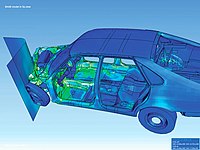
Photo from wikipedia
Abstract As a partition of unity (PU) method, the numerical manifold method (NMM) is able to solve continuous and discontinuous problems in a unified manner. However, the accuracy obtained through… Click to show full abstract
Abstract As a partition of unity (PU) method, the numerical manifold method (NMM) is able to solve continuous and discontinuous problems in a unified manner. However, the accuracy obtained through the traditional NMM (t-NMM) is far from satisfactory, because the strain distribution is constant in each manifold element. To improve the performance of the t-NMM without adding extra nodes or DOFs, the edge-based smoothing technique, which has been applied in the edge-based finite element method (ES-FEM), is incorporated into the t-NMM, resulting in an edge-based smoothed numerical manifold method (ES-NMM). Formulation of the ES-NMM for static, free and forced vibration analyses are presented in great detail. The numerical examples of static, free and forced vibration problems show that the ES-NMM possesses several advantages over the t-NMM, including the close-to-exact stiffness, superconvergence, and ultra-accuracy.
Journal Title: Engineering Analysis With Boundary Elements
Year Published: 2018
Link to full text (if available)
Share on Social Media: Sign Up to like & get
recommendations!